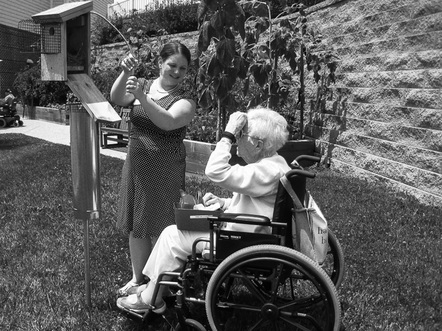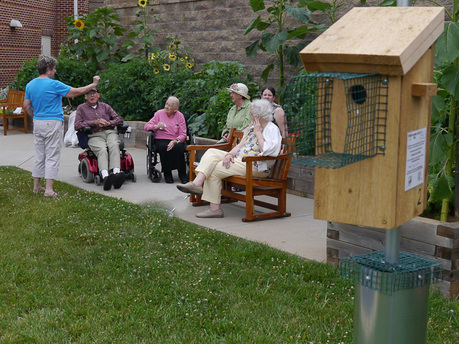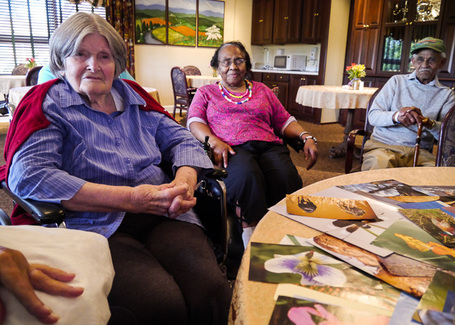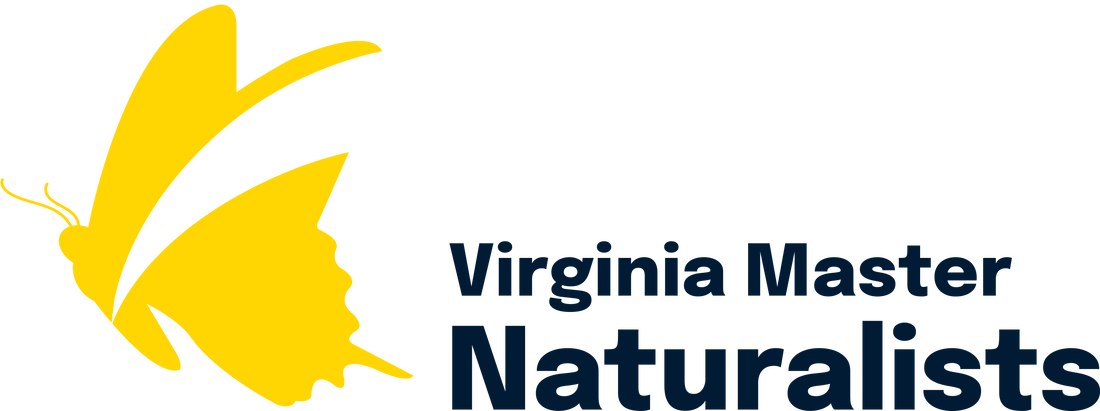 A resident of Dogwood Village checks out the new bluebird box
A resident of Dogwood Village checks out the new bluebird box installed on the property by Virginia Master Naturalist volunteers.
(Photo by Old Rag Chapter)
and Susan Austin Roth (VMN volunteer, Arlington Regional Chapter)
Martha lifts binoculars to her eyes, scans the view from the window and focuses on a flash of blue that came to rest on a birdhouse atop a post in the garden. She exclaims with visible joy, “It’s a bluebird! I haven’t seen one in years!” Even though she can no longer hike in a park or stroll through a garden, thanks to members of the Old Rag Chapter of Virginia Master Naturalists, Martha and other residents of Dogwood Village Health and Rehabilitation and Senior Living, a long-term care facility in Orange, Virginia, enjoy the sights and sounds of nature from their rooms or on the facility’s grounds. In 2012, a dozen or so volunteers, encouraged by the chapter’s vice-president Julie Connelly, developed a program they call the Reconnect with Nature Project: Bringing Nature Home to Long-term Care, which includes various programs to bring nature to residents who otherwise had little access to the natural world. Besides the Bluebird Project, programs include a vegetable garden, a healing garden, an interactive display of nature trivia, both large- and small-group presentations that might include a display of photographic prints, a lecture with projected images, and/or hands-on resources. And for those unable to join a group, volunteers make one-on-one visits to their rooms if requested to do so.
The activities directors and administration of Dogwood Village welcome the master naturalists’ participation, because all these activities encourage the residents to socialize, share memories, and benefit from the healing powers of nature. The volunteers provide not only their time and expertise, but offer their attention, friendship, and kindness to the residents of the long-term care community, all the while connecting the residents with the natural world.
So effective is the chapter’s Reconnect with Nature Project that in September, 2014, the Virginia Health Care Association (VHCA) honored the Old Rag Master Naturalists chapter with its Group Volunteer Award of the Year. The VHCA is an organization of nearly 300 licensed nursing and assisted living facilities in the commonwealth. It advocates for long-term care communities and aims to enhance the quality of life for those living in nursing homes, rehabilitative, and assisted living facilities. Each year the VHCA makes awards to volunteers for outstanding services.
 Long-term care residents at Dogwood Village enjoying an outdoor program
Long-term care residents at Dogwood Village enjoying an outdoor program led by a Virginia Master Naturalist volunteer. (Photo by Old Rag Chapter)
The one-million eight-hundred-thousand people who live in approximately 15,000 long-term care communities in the United States have limited opportunities to connect with the natural world, yet connection to nature is fundamental to health, wellbeing, and the human spirit. Going for walks in nature, sitting outside and looking at a natural scene, looking at trees through the window, and even viewing photographic images of nature all have a restorative impact on wellbeing. Unfortunately, residents of long-term care communities are more often than not confined indoors and must depend on others to assist them in getting outside or experiencing any aspect of nature, and they may not be offered activities that connect them with nature. Long-term care communities are “home” for many elderly and disabled, yet in this home meant to foster health, many residents are disconnected from the healing power of the natural world.
To explore ways to meet this need in her community, then vice-president Julie Connelly, M.D., invited interested members of the Old Rag Chapter (ORMN) to assess their skills and interests and explore ways they could use them to address the disconnection with the natural world experienced by long-term care residents. Their brainstorming resulted in the Reconnect with Nature program, which aims to help residents find more joy in their lives by connecting with nature and igniting their curiosity and wonder, feelings that might have been forgotten or not acknowledged for a long time. The residents’ responses to these programs, as evidenced by their words, facial expressions, and gestures show how well this program works. Expressions of joy, appreciation, and surprise, and often the resurfacing of memories allowed them to connect the past with the present. Textures and smells of pieces of the natural world sparked liveliness and remembrance. Friendships among the residents and the volunteer naturalists developed. Friendships also developed among residents, especially around the vegetable garden during the summer months. The residents express how much they look forward to the next activities, which inspires both the volunteers and staff to continue this work and demonstrates the importance of connecting the residents with the natural world.
 Long-term care residents participate in "Adventures in Nature",
Long-term care residents participate in "Adventures in Nature", an opportunity to both learn and share memories about nature.
(Photo by Old Rag Chapter)
Vegetable Garden: ORMN member Cherri Lawson volunteered to lead development of the vegetable garden at Dogwood Village Senior Living, a request by the staff because they did not have gardening experience. Working with the Dogwood Village staff, she meets with residents on Mondays from 1-3 p.m. during the spring, summer, and fall. Several ORMN volunteers help Cherri with planting and garden maintenance. She tries to directly involve residents with personalized garden plots where they grow vegetables and also flowers. Weekly visits build an exciting and cooperative spirit in the garden, which has become a place to socialize. Residents pick their own produce to share with family members and other residents, and the staff prepares some of the veggies for the residents’ meals. The garden succeeded on all levels, and residents even entered their produce in the Orange County fair where a number of them won prizes: Buck Harris won Best in Show 1st Place for his perfect tomatoes; Jeanne Davis won Best in Show 1st Place for the tallest sunflower plant; Fred Miller won 1st Place Tomatoes, and others won prizes for chives, miniature roses, and marigolds.
Blue Bird Trail: Dana Squire, an ORMN volunteer and member of the Virginia Bluebird Society, determined that the nursing home grounds were appropriate for a five-box blue bird trail. Roger Temples (ORMN) built the boxes, and five members helped install them. The residents quickly noticed the boxes, and they enjoy watching them with binoculars from their rooms. They talk enthusiastically about sightings, and especially enjoy sighting newly-laid eggs and observing the birds fledge. Dana visits the facility weekly from March to November to maintain the bluebird trail. If capable and interested, residents can participate during the weekly visits.
Large-Group Presentations: Many members of ORMN offer large-group presentations to the residents, who enjoy the educational nature of the presentations and are often inspired to tell stories of their own experiences in nature from around the world. Examples of presentations include: What is Nature? (Connelly); Blue Birds in the Backyard (Temples); God’s Coloring Book (Price); Chestnut Blight and Restoration (Baker); A Hike Up Old Rag in Shenandoah National Park (Connelly); Exploration of a Coral Reef (Marshall); Wild Animals of Africa (Williams).
Small-Group Sessions: Usually twice a month, three members (Julie Connelly, Caroline Watts, and Jane Dalton) offer small-group sessions called “Adventures in Nature.” Many sessions involve passing around photographs to facilitate resident storytelling, and others include demonstrations using hands-on resources such as rocks (geology), fall leaves (pigmentation of leaves), local wildflowers and butterflies. The residents enjoy the educational intention of the presentations along with the opportunity to socialize.
One-on-One Visits: Some nursing home residents are not able to attend either large- or small-group sessions, so volunteers visit them in their rooms (Julie Connelly and Jane Dalton). The staff provides names of those interested in having personal visits. The volunteers found that sharing nature pictures encourages the residents to share recollections and tell stories that bring the joy they felt in the past into the present moment.
Healing Garden: Pam McMillie has been adding native plants, especially those that are nectar and host plants for butterflies, to a newly established garden at the facility. She also offers presentations to the residents about the plants, and she developed a plant identification map, which is useful both for residents and their families.
Nature Trivia: Gail Marshall offers a question-answer display board where she provides questions and interactive answers about many aspects of nature, e.g., native wildflower identification, coral reef creatures.
The Old Rag chapter’s Reconnect with Nature Project: Bringing Nature Home to Long-term Care demonstrates that Master Naturalists can play an important role in improving the quality of life for people who are confined to a long-term care facility. Living in an institution need not translate into being disconnected from the natural world. Other chapters might follow this example and develop similar projects of their own.


 RSS Feed
RSS Feed